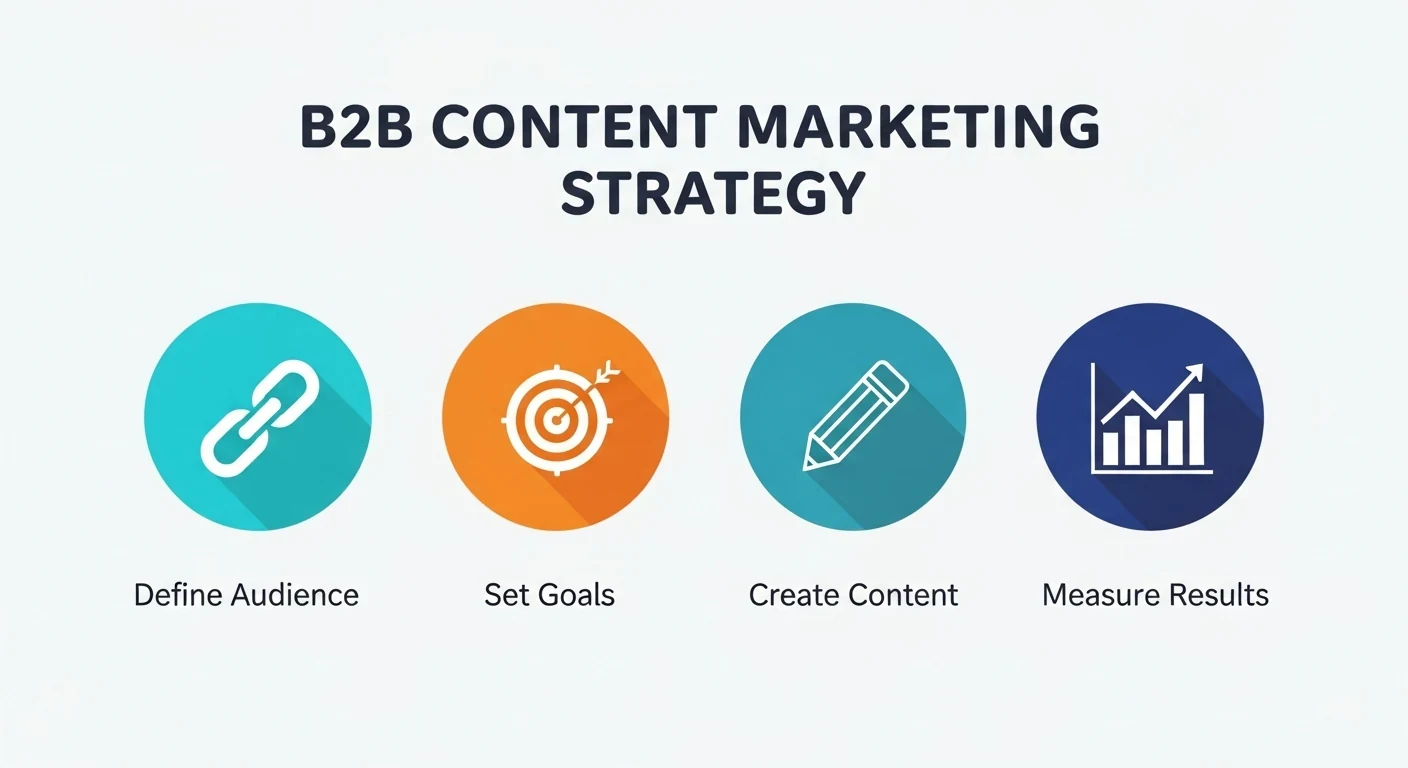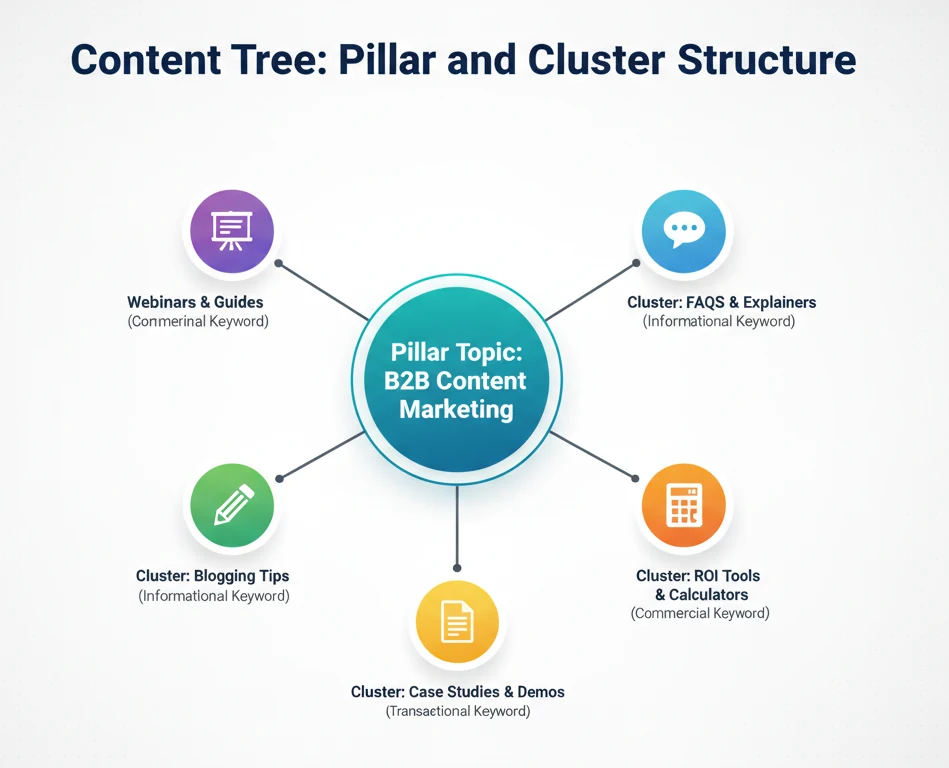Knowing how to do B2B content marketing to generate leads is the heart of modern B2B growth. Today’s buyers spend most of their time researching on their own, often long before they ever talk to a sales rep. That means the content they see, trust, and act on decides whether you even make it to their shortlist.
Join Wise Advertisement and learn the best practices for a B2B lead-generating content marketing strategy.
What is a B2B Content Marketing Strategy?
A strategy for B2B content marketing to generate leads is a plan for how a business uses content to attract and convert other businesses. It defines:
- Who the audience is
- What type of content they need
- Where it will be shared
- How success will be measured
This leads directly to lead generation because most B2B buyers now complete around 70% of their research before talking to sales. On average, they review about 13 pieces of content before making a decision.
For example, a company offering software might publish a “Beginner’s Guide” to capture early interest, then share a case study showing real results to build trust. Step by step, this strategy turns curious visitors into qualified leads ready for sales.

Why Is B2B Content Marketing So Essential for Lead Generation?
You will become a powerhouse if you use B2B content marketing to generate leads. It matters so much because:
- Everyone’s doing it and seeing results. About 91% of B2B marketers use content marketing, and 74% say it works for getting leads.
- It drives real leads efficiently. Content marketing delivers three times more leads than traditional outbound methods and costs about 62% less.
- Most buyers rely on content. Around 76% of marketers say they depend on content to bring in leads, and 60% of buyers make their final decision based on the content they find.
- Blogs matter all the way down the funnel. Businesses that blog regularly generate 67% more leads and are 13 times more likely to see a positive ROI from their content.
This importance makes many companies use the services of B2B content marketing agencies in Phoenix.
How to Build a B2B Lead-Generating Content Marketing Strategy
A good strategy doesn’t happen overnight. Your job is to plan what buyers research and find, guide them through each step, and give them simple ways to engage. Let’s see how to develop a strategy for B2B content marketing to generate leads:
Set Clear Goals
Before you start writing, decide what you want to achieve. Is the goal to get more people booking demos? More qualified leads? More revenue? Write it down.
Talk to your sales team so you agree on what counts as a “good lead.” If marketing says one thing and sales says another, no one’s happy. Also, track where leads come from, whether it’s a blog post, a webinar, or a social ad. That way, you know what’s working and what’s just noise.
2) Know Your Audience
In B2B, you’re convincing a group. A deal often needs approval from the boss, the tech person, the future user, and the finance team. Each of them cares about different things.
- The boss wants to see a return on investment.
- The tech person cares if it fits with existing tools.
- The end user wants it to be simple to use.
- Finance wants the numbers to make sense.
If you don’t create content for all of them, someone will say no. Also, you should think of the basics like industry, company size, budget, and common pain points.
Map the Buyer Journey
People don’t buy big solutions overnight. They ask different questions at different stages. Matching your content to those questions keeps them moving forward.
|
Stage |
What buyers ask |
Best content to give them |
|
Awareness |
“What problem do I have?” |
Blog posts, short videos, infographics |
|
Consideration |
“What are my options?” |
Webinars, guides, comparison charts |
|
Decision |
“Why choose you?” |
Case studies, demo videos, customer stories |
If you only make one kind of content (say blogs), you’ll miss buyers who are closer to making a decision.
Choose Main Topics (Pillars), Clusters, and Keywords
Don’t just chase random keywords. Build around big “pillar” topics that reflect major pain points in your industry. Then create smaller “cluster” articles that go deep into sub-topics and link back to the pillar. Use a mix of informational, commercial, and transactional keywords so you cover the full journey. This structure tells Google you have authority and makes it easier for readers to navigate.
For example, HubSpot built a huge guide to inbound marketing. Around it, they published smaller articles on things like blogging tips, email templates, and social media. All those branches made the trunk stronger in Google search.

Pick the Right Formats
Different people are at different stages when they discover your business. That’s why your B2B content marketing to generate leads should match the marketing funnel:
|
Funnel Stage |
Definition |
Best Content Types |
Purpose |
|
Top of the Funnel (TOFU) |
Awareness stage: people know they have a problem but not the solution yet. |
Short blogs, checklists, simple explainers |
Grab attention and build trust |
|
Middle of the Funnel (MOFU) |
Consideration stage: buyers compare options and look for details. |
Webinars, ROI calculators, comparison sheets |
Show value and educate on solutions |
|
Bottom of the Funnel (BOFU) |
Decision stage: buyers are ready to choose but need proof. |
Case studies, demo videos, customer success stories |
Build confidence and drive conversions |
Mixing content across all three stages makes sure you guide people smoothly from curiosity to confidence, and finally to becoming a lead.
Use Forms Carefully
If you’re giving away something valuable, like a full industry report or a detailed template, it’s okay to ask people for their email. But don’t hide simple content like blogs behind a form. Keep forms short. Just a name and email often works. If you ask for 10 things, most people will walk away.
Stay Consistent with a Content Calendar
Random posting doesn’t build trust, and you won’t see results. A calendar helps you stay consistent and accountable. Plan a calendar that works for your resources, for example, two blogs, one case study, and one webinar per month. Be aware of the owner, deadlines, target persona, and KPI for each. Consistency builds authority and keeps the pipeline flowing.
Share Your Content Everywhere It Matters
Publishing is only half the job. You need to get eyes on the content:
- Your website and email list
- LinkedIn and other social platforms
- Partner sites, guest posts, or communities
- Paid ads if you want more reach
Track where people come from so you know which channels bring real leads.
Optimize for SEO and Mobile
Brilliant content means nothing if your page takes six seconds to load. No one waits for slow websites! Keep pages loading under three seconds, especially on mobile. Use clean on-page SEO (title tags, H1s, subheads, and internal links). Add author bylines, expert quotes, and updated dates to show authority. Remember! A one-second delay in page load time can reduce conversions by 7%, according to a report highlighted by Forbes.
Sort Leads by Interest
Not every visitor is ready to talk to sales. Some are just browsing, while others are checking pricing. Use intent signals to tell the difference:
- High interest = demo requests, pricing page views
- Medium interest = webinar sign-ups, multiple blog reads
- Low interest = one quick blog visit
Send hot leads to sales right away. Keep the rest warm with follow-up emails or retargeting ads.
Review and Update Often
Track both outcomes and inputs (downloads, webinar sign-ups, content-assisted conversions). Which blogs bring in the most leads? Which webinars flop? Update winning content every 6–12 months to keep it fresh and ranking. Kill off anything that’s outdated, not working, or underperforming. Stale or duplicate content hurts trust with both users and Google.
Repurpose What Works
Don’t let a good piece of content die after one use.
- A research report can become three blogs, a webinar, and a set of LinkedIn posts.
- A case study can become a short video, a quote for social, and a slide for sales decks.
Repurposing extends reach and saves production time. This way, one idea keeps working for months instead of weeks.
What Content Type Is Mostly Used for B2B Lead Generation?
If you want to use B2B content marketing to generate leads, you need to know which content formats B2B marketers rely on:
|
Content Type |
Usage by B2B Marketers |
Why It’s Effective for Lead Generation |
Best Funnel Stage |
|
Short articles / blog posts |
~92–89% |
Quick, easy to read, drives organic traffic. |
TOFU |
|
Videos |
~76% |
Engaging, boosts understanding, linked to leads. |
TOFU / MOFU |
|
Case studies / customer stories |
~75% |
Show proof, build trust, convert late-stage buyers. |
BOFU |
|
Webinars |
~89% effectiveness |
Capture sign-ups, deliver deep engagement. |
MOFU |
|
Long articles |
~69% |
Strong SEO, good for in-depth learning. |
MOFU |
|
Visual content (infographics, charts) |
~57% |
Simplifies data, easy to share, boosts engagement. |
TOFU |
|
E-books / white papers |
~51% |
In-depth value, effective gated lead magnets. |
MOFU / BOFU |
Notes:
- Short articles and blog posts are the backbone of content marketing for B2B. Nearly every marketer uses them because they’re simple and effective.
- Videos, case studies, and webinars drive deeper engagement, build trust, and move leads closer to a decision.
- Long-form content, visuals, and e-books shine in nurturing and gated campaigns where capturing qualified leads is the goal.

How Do You Write B2B Content That Generates Leads?
Writing B2B content that generates leads is about writing with purpose, clarity, and authority. Just like building the strategy step by step, the writing phase needs structure, empathy, and attention to detail.
Lead with a Clear, Compelling Headline
Your headline is your first handshake with the reader. Make it specific, benefit-driven, and clear:
- “How to Reduce Software Integration Time by 50%”
- “10 Proven Steps to Cut Procurement Costs in Tech”
Avoid vague titles like “Best Solutions for Your Business.” A pointed headline builds trust and sets expectations, which is crucial for busy B2B readers.
Hook Them Fast with a Relatable Intro
Start with a short, conversational intro that connects with a pain point:
"If your team is wasting hours wrestling with slow onboarding… you're not alone. Every day, 60% of B2B managers say they lose productivity due to integration headaches."
A relatable problem statement plus a data point hooks attention. Then say simply what they’ll learn next.
Organize Content by Audience Roles and Needs
In B2B, you’re writing for many people, not just one. Structure content so each role sees their part:
|
Section Title |
Who It Speaks To |
What It Covers |
|
ROI and Strategy |
Economic Buyer |
Investment returns, productivity gains |
|
Implementation & Integration |
Technical Evaluator |
APIs, compatibility, migration steps |
|
Day-to-Day Experience |
End User |
Ease of use, onboarding, support |
|
Security & Compliance |
Procurement / Legal |
Certifications, data handling, compliance |
This layered approach assures each reader they’re seen and heard—without being repetitive.
Write in Plain Language and Active Voice
Skip jargon and wordiness. Keep sentences short, direct, and active:
- Good: “Our tool saves teams 30% of onboarding time.”
- Avoid: “Onboarding time is reduced by 30% with the utilization of our tool.”
Plain, active language reads easily. It boosts comprehension and trust. In B2B, that clarity often nudges people toward conversion.
Use Data-Driven Proof and Mini Case Examples
Numbers and stories build credibility instantly. For example:
"Company X automated billing with our platform and recovered $120K in monthly revenue—50% faster invoicing."
Or do a brief, bulleted mini-case:
- Challenge: Took 10 days to invoice clients.
- Solution: Automated billing module.
- Result: Invoicing in under 5 days; 40% revenue growth in 30 days.
If you show real numbers and the results, you will have social proof that qualifies your content.
Include Mid-Content CTAs that Match Intent
Don’t push the main CTA too early. Give value first, then prompt:
"Want to see our billing dashboard in action? Watch a 5-minute demo now."
Make the CTA relevant to what they just read. Contextual placement converts better than a lone button at the end.
Add Visuals Intelligently
Visuals make your content friendlier and easier to scan. Use:
- Charts or graphs to show before/after results.
- Diagrams that explain workflow improvements at a glance.
Even a simple annotated screenshot can clarify a key point, and visuals get shared more often on social media.
Wrap with a Strong Conclusion and CTA
Finish with a quick wrap-up and invitation:
"You've seen how faster billing, better transparency, and saved time lift ROI. Ready to cut your invoicing cycle in half? Let's talk. Our team can show you how it works in minutes."
Make it easy to understand. Readers shouldn’t wonder what to do next. Clarity equals action.
The Bottom Line
At the end of the day, using B2B content marketing to generate leads is about being clear, consistent, and customer-focused. It’s also about solving real problems, showing evidence, and creating a smooth path from interest to action. When you build content that speaks to different roles, answers real questions, and offers next steps, you stop chasing leads and start attracting them.
Want to turn your content into a steady flow of qualified B2B leads? Book a FREE consultation with Wise Advertisement today and see how we can help your business grow.
FAQ
How to use B2B content marketing for B2B lead generation?
Create content that solves buyer problems, align it with their journey, and add clear CTAs to capture leads.
Why is content marketing important to B2B?
It builds trust, educates buyers before sales calls, and drives consistent, cost-effective lead generation.
How to generate leads with content marketing?
Use blogs, case studies, webinars, and gated assets to attract interest, then convert readers with forms, demos, or trials.
How to generate leads in B2B?
Target the right ICP, publish value-driven content, distribute it widely, and nurture prospects until they’re sales-ready.
How to do B2B content marketing?
Plan around goals, buyer personas, and journey stages; create varied formats; distribute strategically; and measure pipeline impact.





